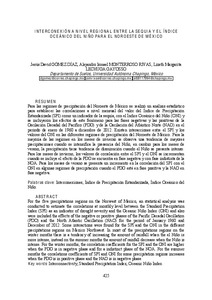Por favor, use este identificador para citar o enlazar este ítem:
http://hdl.handle.net/20.500.11765/8200
Interconexión a nivel regional entre la sequía y el índice oceánico del Niño para el noroeste de México
| Título : | Interconexión a nivel regional entre la sequía y el índice oceánico del Niño para el noroeste de México |
| Autor : | Gómez Díaz, Jesús David; Monterroso Rivas, Alejandro Ismael; Lechuga, Lizeth Margarita |
| Palabras clave : | Interconexiones; Índice de Precipitación Estandarizada; Índice Oceánico del Niño; Interconnectivity; Standard Precipitation Index; Oceanic Niño Index |
| Fecha de publicación : | 2014 |
| Editor: | Asociación Española de Climatología |
| Citación : | Fernández Montes, Sonia; Sánchez Rodrigo, Fernando (eds.). Cambio climático y cambio global. Madrid: Asociación Española de Climatología, 2014, p. 425-434 |
| Resumen : | [ES]Para las regiones de precipitación del Noroeste de México se realizó un análisis estadístico
para establecer las correlaciones a nivel mensual del valor del Índice de Precipitación
Estandarizada (SPI) como un indicador de la sequía, con el Índice Oceánico del Niño (ONI) y
se incluyeron los efectos de este fenómeno para las fases negativas y las positivas de la
Oscilación Decadal del Pacífico (PDO) y de la Oscilación del Atlántico Norte (NAO) en el
periodo de enero de 1960 a diciembre de 2012. Existen interacciones entre el SPI y los
valores del ONI en las diferentes regiones de precipitación del Noroeste de México. Para la
mayoría de las regiones en los meses de invierno se observa una tendencia de mayores
precipitaciones cuando se intensifica la presencia del Niño, en cambio para los meses de
verano, la precipitación tiene tendencia de disminución cuando el Niño se presenta intenso.
Para los meses de invierno, los valores de correlación entre el SPI y el ONI se incrementan
cuando se incluye el efecto de la PDO se encuentra en fase negativa y con fase indistinta de la
NOA. Para los meses de verano se presenta un incremento en la correlación del SPI con el
ONI en algunas regiones de precipitación cuando el PDO esté en fase positiva y la NAO en
fase negativa. [EN]For the five precipitations regions on the Norwest of Mexico, an statistical analysis was conducted to estimate the correlations at monthly level between the Standard Precipitation Index (SPI) as an indicator of drought severity and the Oceanic Niño Index (ONI) and also were included the effects of the negative or positive phases of the Pacific Decadal Oscillation (PDO) and the North Atlantic Oscillation (NAO) for the period of January 1960 and December of 2012. Some interactions were found for the SPI and the ONI in the different precipitations regions on Mexico Northwest. In most of the precipitations regions on the winter months there is a tendency of increasing the amount of rainfall when the el Niño is more intense, instead on the summer months the amount of rainfall decrease when the Niño is intense. For the winter months, the correlation coefficients for the SPI and the ONI are higher when the PDO is in negative phase and for a indistinct phase of the NOA. For the summer months the correlations coefficients of SPI and ONI for some precipitation regions increases when the PDO is in positive phase and the NAO is in negative phase |
| Descripción : | Ponencia presentada en: IX Congreso de la Asociación Española de Climatología celebrado en Almería entre el 28 y el 30 de octubre de 2014. |
| URI : | http://hdl.handle.net/20.500.11765/8200 |
| ISBN : | 978-84-16027-69-9 |
| Colecciones: | (2014, Almería). IX Congreso AEC |
Ficheros en este ítem:
| Fichero | Descripción | Tamaño | Formato | ||
|---|---|---|---|---|---|
| 0040_IX-2014-JD_GOMEZ... | 452,72 kB | Adobe PDF |  Visualizar/Abrir |
Los ítems de Arcimis están protegidos por una Licencia Creative Commons, salvo que se indique lo contrario.





